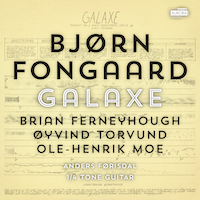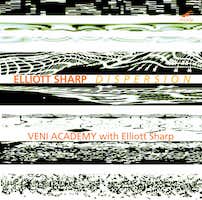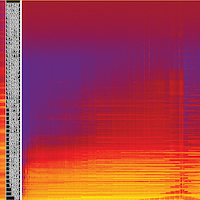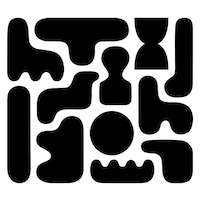String Theory 35: Mostly Guitars
|
Grant Chu Covell [December 2020.]
“Galaxe.” Bjørn FONGAARD: Inventions for ¼-tone guitar, Op. 32 (1964); 3 Concertinos for ¼-tone guitar and percussion, Op. 36 (1964); Reflections for ¼-tone guitar and voice, Op. 33 (1964); Sonata No. 1 for microinterval guitar, Op. 48 (1971); Sonata No. 2 for microinterval guitar, Op. 58 (1975); Galaxe, Op. 46 (1966); Aphorisms for microinterval guitar, Op. 61 (1967); Notations for microinterval guitars, Op. 62 (1967); Aphorisms for microinterval guitar, voice and percussion, Op. 63 (1967); Improvisations for microinterval guitar, Op. 81 (1968); Sinfonia Microtonalis No. 1 (1970). Brian FERNEYHOUGH: Renvoi-Shards (2010). Ole-Henrik MOE: KRAV (2007). Øyvind TORVUND: Guitar in the Mud (2014). Anders Førisdal (e-guit, voice, perc), Håkon Stene (¼-tone vibr, perc), Eirik Raude (perc). Aurora ACD5068 (2 CDs) (www.aurorarecords.no). A remarkable collection of music for microtonal electric guitar: Imagine Scelsi plus Hába plus Stockhausen plus Hendrix. Fongaard explored electric guitar tunings and extended techniques, and employed tape effects as they became available. If Fongaard is unknown outside of his native Norway, it is because his notation was specific, and he had no immediate students with which to cultivate a performance practice. Fongaard’s own recordings are obscure (Elektrofoni: Works For Micro Intervallic Guitar 1965-1978, Prisma CD711), but with this set, Førisdal pins Fongaard securely onto the map. Start anywhere. The guitar groans like a whale or buzzes like a mosquito, and when there are distinct pitches, they are microtonal and stick between the cracks. Hallmarks of electronic music thrive: distortion, noise clouds, pedal tones, clear sine waves. Right from the start with Inventions Fongaard clearly asserts his aesthetic and technique. In Reflections and Aphorisms the player must speak and play percussion. Sonata No. 1 includes amplified scraping sounds. If you have to focus upon one opus, then it should be the astonishing Galaxe for three guitars. At 12 minutes, the work suggests its own universe rather than space travel. As he was investigating this music, Førisdal commissioned new pieces. Ferneyhough’s Renvoi-Shards is not so different from the surrounding Fongaard, but is nonetheless surprising as it is precisely notated whereas Fongaard achieved similar sounding complexity with graphic notation. KRAV works with the resonances and blurring created by microtonal bells and guitar moving in and out of phase, a high-register feedback etude. Torvund’s Guitar in the Mud uses a skiffle pedal and ring modulation to extract gritty and goofy sounds.
“Dispersion – Music for Systems Orchestra.” Elliott SHARP: Flexagons (2013)1; Dispersion of Seeds (2003)2; The Hidden Variable (2014)3; Palimpsest (2015)4. Elliott Sharp3,4 (e-guit), Veni Academy1,2,3,4, Marián Lejava1,2,3,4 (cond.). mode 305 (1 CD) (www.moderecords.com). In Flexagons, repeating cells ebb and crest according to a hidden strategy. It’s like standing at the center of a busy rotary. Flexagons’ volume level is constant whereas Dispersion of Seeds is not, and the pitch material and general fidgeting suggest tuning ahead of a concert’s start. The Hidden Variable sets Sharp in front as guitar soloist exploring his graphic scores alongside subtle and sympathetic accompaniment from a smaller ensemble. Palimpsest braids these threads together: Patterns evolve at the established pace, but the full ensemble indulges in controlled chaos. Recordings of improvisation pale in comparison to actually taking part, however, these items elicit interesting sounds and capture the energy, impressive considering that Veni Academy are students and that Sharp had not worked with them before.
“New Strings Attached: Contemporary Music for Guitar by Young Israeli Composers.” Gilad COHEN: The Rushing Camel (2012)1. Yair KLARTAG: Nothing to express (2014)2. Jonathan KEREN: Three Ladino Songs (2008)3. Guy BARASH: TalkBack III (2010)4. Ronne RESHEF: Four Bailik Children’s Songs (2009)5. Nadev LEV: Shomeret Layla (2013-14)6. Nadev Lev1,2,3,4,5,6 (guit, e-guit), Mivos String Quartet2, Tehila Nini-Goldstein5 (sop), Rinat Shaham3, Re’ut Ben-Ze’e6 (m-sop), Miranda Cuckson3 (vln), Guy Barash4,6 (electronics). Delos DE 3488 (1 CD) (www.delosmusic.com). The subtitle may suggest an arcane collection, but these works represent the guitar’s breadth. Cohen’s The Rushing Camel establishes connections to the guitar tradition with nods to the Spanish repertoire, but soon diverges with knocks and coarse playing techniques. I have no firsthand experience of camels but enjoy the illustration. The two sets of songs, by Keren (for mezzo, violin and guitar) and Reshef (for soprano and guitar) are predominantly tonal and infused with identifiable folk elements. A nearly extinct language, Ladino is also known as Sephardi or Judeo-Spanish; Keren’s trio is finely crafted. Nothing to express for string quartet plus electric guitar emphasizes the plugged-in instrument’s crispness, as the five players sizzle and whine. The electric guitar appears in varied splendor, challenging and cajoling the quartet, recalling Italian works heard here. Barash’s delaying effects in TalkBack III create dust clouds or fractured multiples of Lev’s antics. The guitarist’s own Shomeret Layla, a remembrance of lullabies on a kibbutz, unexpectedly turns menacing. As the electric instrument buckles and twists, a shushing sound threatens instead of soothes.
“Warmth.” Steve REICH: Electric Counterpoint (1987). Paul KEREKES: Trail (2015). David LANG: Warmth (2006). James TENNEY: Septet (1981/2000). Trevor BABB: Grimace (2013). Carl TESTA: Slope 2 (2016). Trevor Babb (e-guit). Innova 972 (1 CD) (www.innova.mu). We should accept that Reich’s Electric Counterpoint isn’t a counterpoint study, but a guitar orchestra disguised as a gamelan. Babb’s multi-tracking provides a consistent texture for the shifting upper melodic voices and the underlying harmonic changes. Kerekes’ Trail is a gentle treble-pitched gyration. Lang’s tricky duet, Warmth, is a canon that refuses to get going. Across perpetually changing meters, each player may present the same pitches, but at different rhythms. The results evoke a pentatonic African tune. In Tenney’s Septet, a crinkly equal-tempered chord climbs upwards, shedding bass notes until only a cloud remains, and then descends again into different packaging. Babb’s Grimace asks for electrified glissandos. This may be the grittiest and most uncomfortable item on the program, as the swooping instrument pursues something primal. Towards the end it is as if the strings are gradually detuned as low as they will go, creating a guttural effect. Testa’s Slope 2 is an atmospheric ramble, with improvisation and a fair amount of distortion.
“Solos.” Matteo LIBERATORE: Var. comps. (2017). Matteo Liberatore (guit). Innova 985 (1 CD) (www.innova.mu). A single, confident guitar closely miked without dubbing or other electronic effects sings, growls and splutters across these stimulating improvised tracks. Beyond plucking, knocking, strumming and rubbing, we hear what may be knitting needles tapping gently and metal, plastic or glass objects scraping the strings. There are no notes, only the cover’s suggestive forms and the twelve titles: “Agnes,” “Untitled #9,” “Gravity,” “Chimera,” “Coral,” Barrea,” “Alberto,” “Ubiquitous,” Causeway,” “MMXVI,” “Fisherman” and “Matryoshka.” Press coverage on Liberatore’s site suggests the first track is a nod to painter Agnes Martin.
Babb, Barash, D Lang, Ferneyhough, Fongaard, G Cohen, Kerekes, Keren, Klartag, Lev, Liberatore, Moe, Reich, Reshef, Sharp, Tenney, Testa, Torvund
[More Grant Chu Covell, String Theory]
[More
Babb, Barash, D Lang, Ferneyhough, Fongaard, G Cohen, Kerekes, Keren, Klartag, Lev, Liberatore, Moe, Reich, Reshef, Sharp, Tenney, Testa, Torvund]
[Previous Article:
Used Bin Troll Tweets UU.]
[Next Article:
Piano Factory 27.]
|




